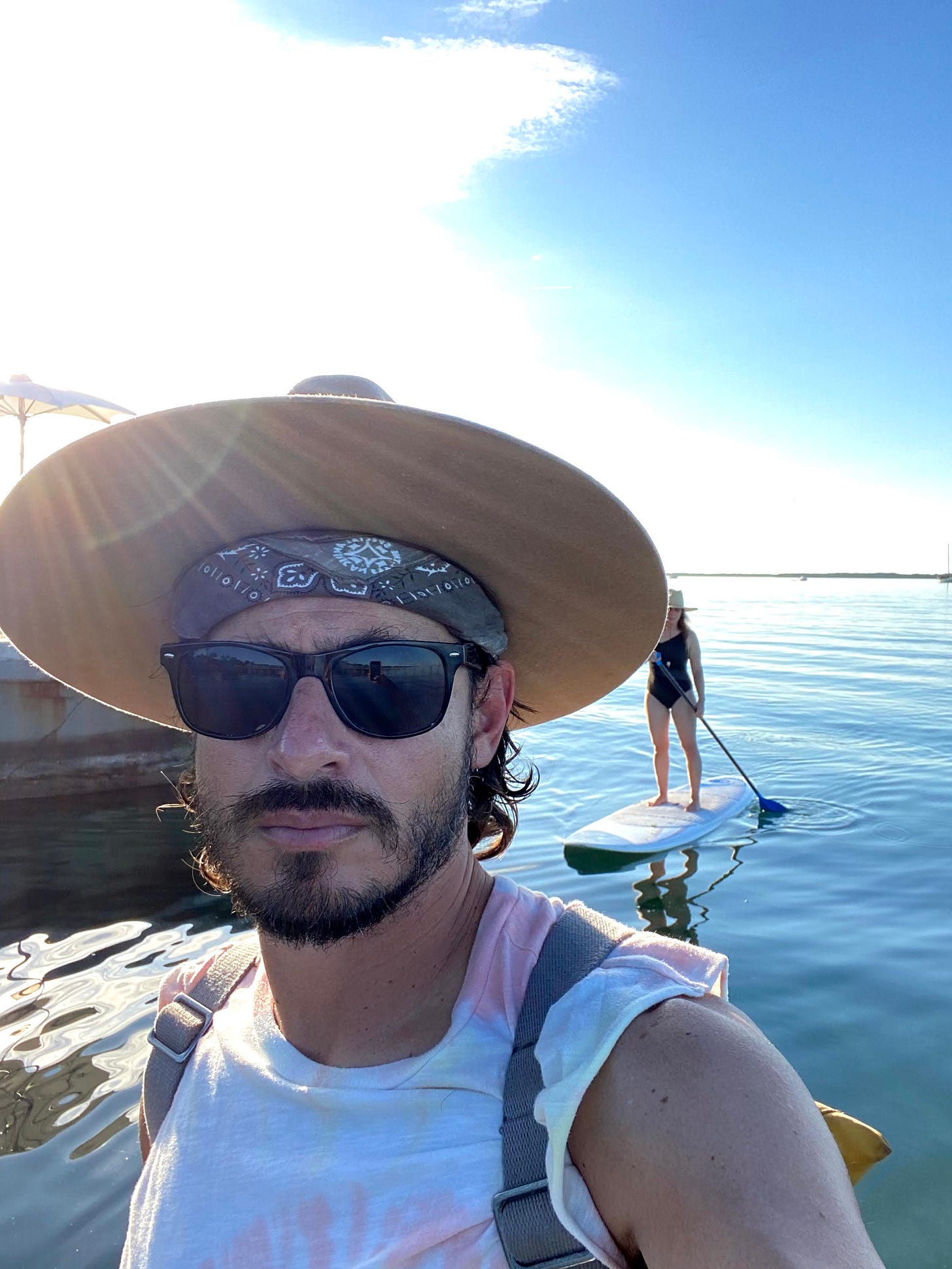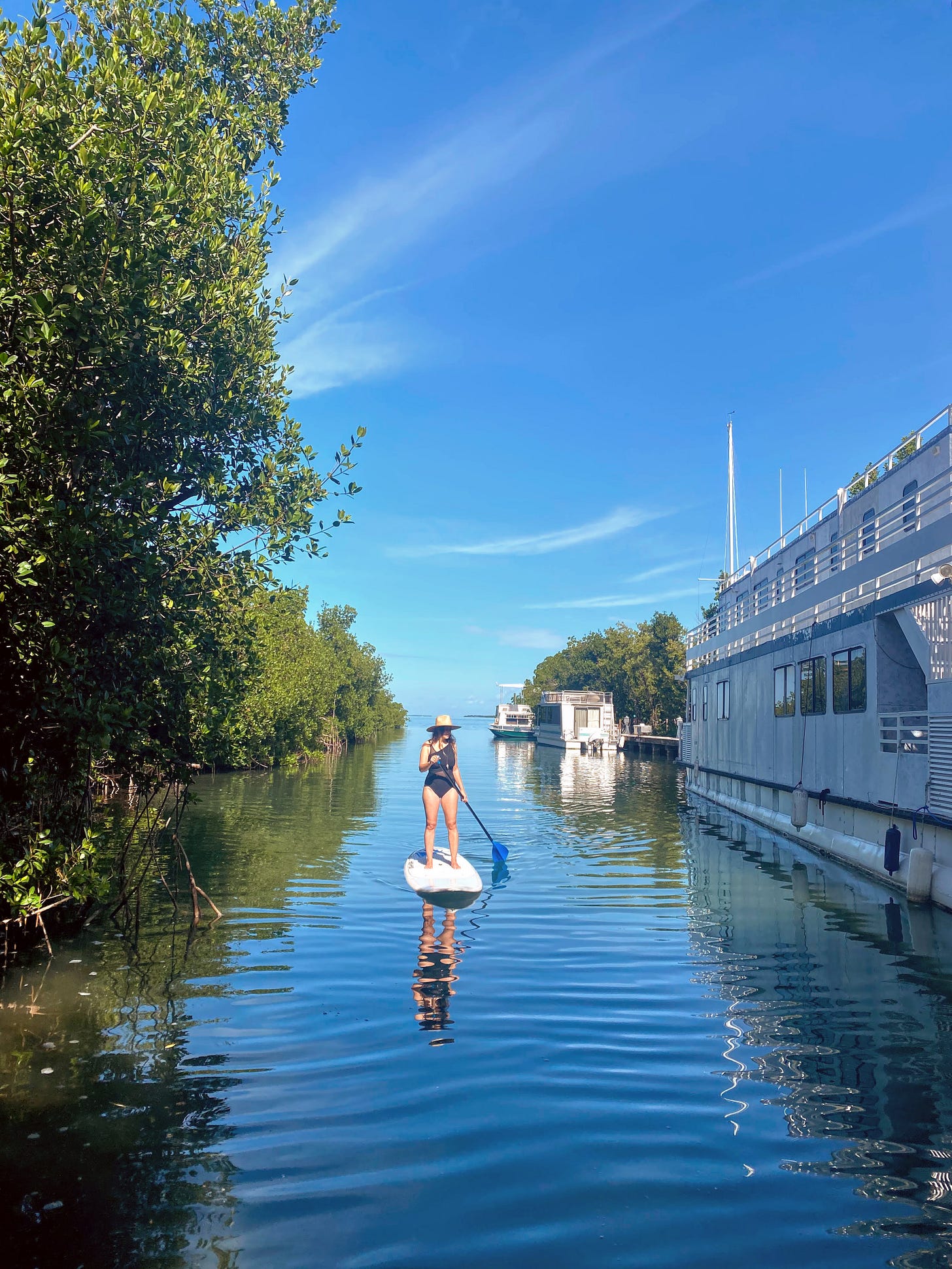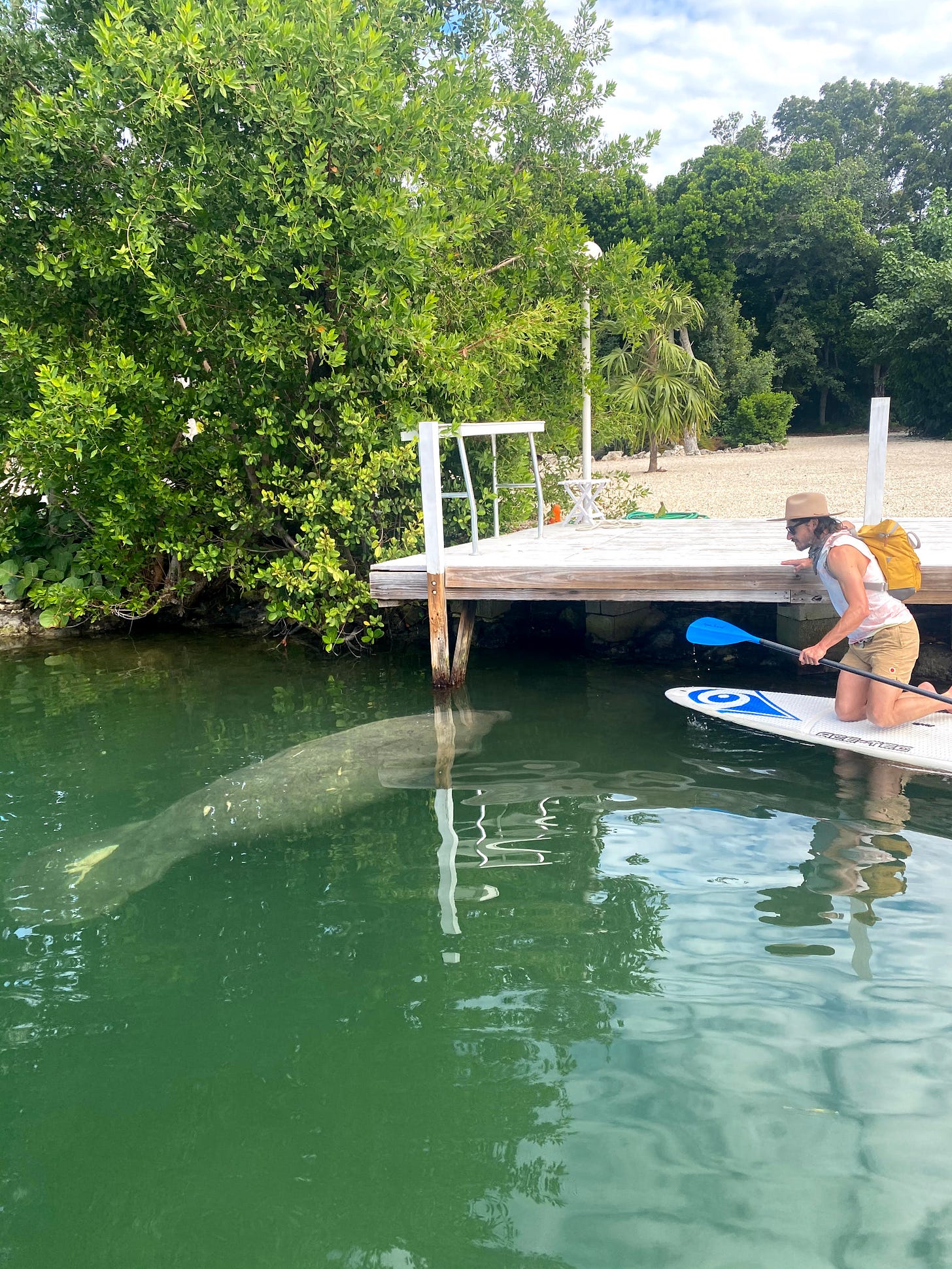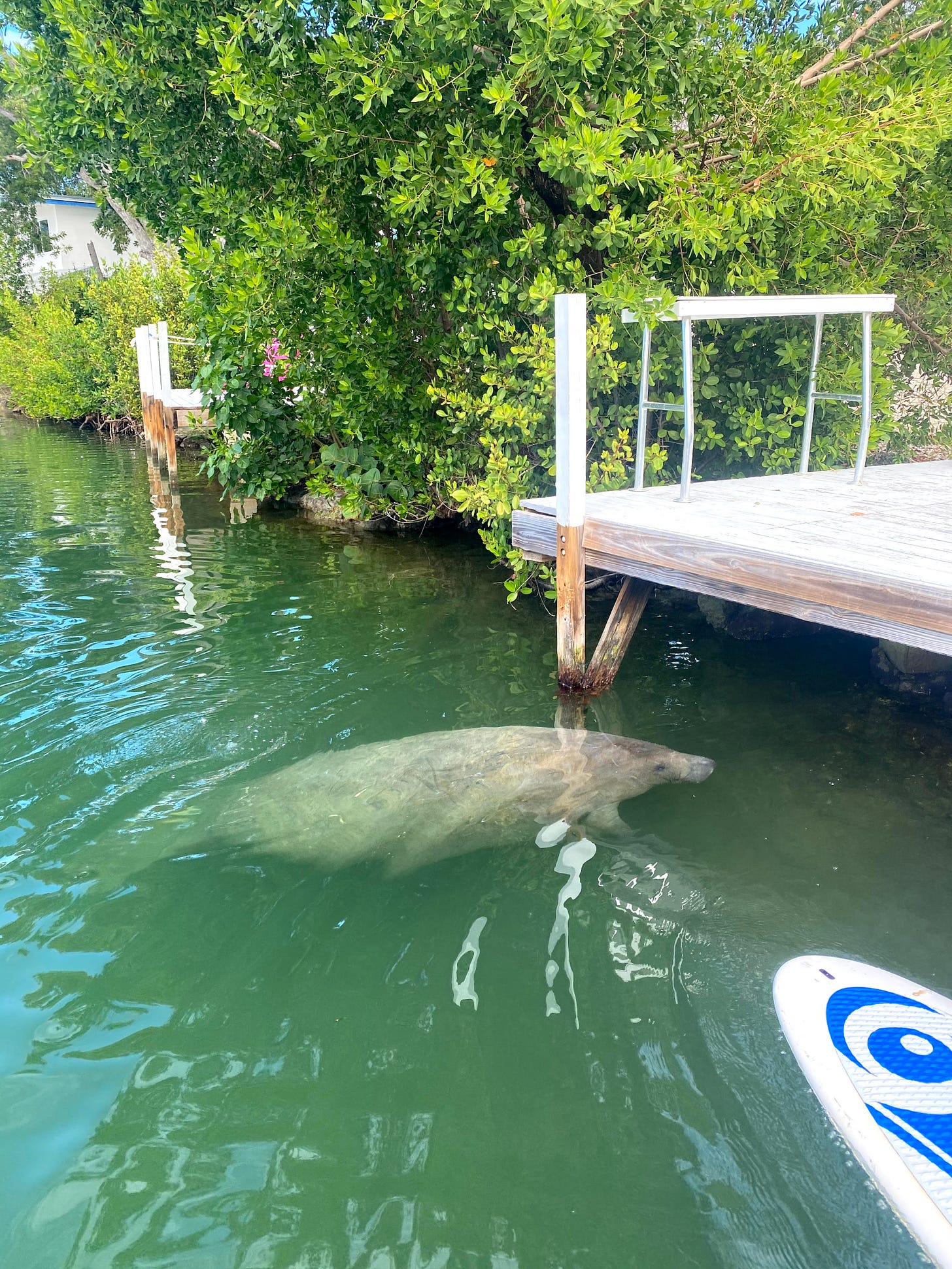The Scent of Manatee Breath
It's a pungent and warm reminder that we mammals are made of similar stuff
I’ll never forget the first time I smelled manatee breath. It happened more than four years ago, but the memory is as strong as ever. My wife and I were exploring some of the back canals of Islamorada in the Florida Keys on a couple of rented, foamy stand-up paddleboards. At some point, we realized that a giant, old manatee was swimming alongside us. We decided to follow him or her for a little while, and we all checked each other out. He submerged, and I crouched over the water's surface, trying to get a better look, when out of nowhere, a massive skull emerged from the dark green waters, plunking itself almost on top of my paddleboard. The ginormous head weighed enough to nearly tip me over. And then the rest of the body rose to the surface like a massive oblong beach ball, extending longer than my 9-foot paddleboard. I realized it was a friendly being, so I regained my balance and stayed put. He looked at me intentionally, curiously, to assess me and try to understand why this strange homosapien was prostrate on a board with his head so close to the water. His dark, vulnerable eyes radiated with intelligence, gazing directly into my eyes from a kissable distance. Don’t worry; we didn’t engage in cross-species relations.
On the contrary, what would happen next was quite the turn-off. As I was staring into the soul of this ancient sirenian whose closest living relative is an elephant, suddenly, these two circular slots at the top of his head slid open like automatic sliding doors at the supermarket. The circles on this Florida manatee (T. m. latirostris), a subspecies of the West Indian manatee (Trichechus manatus), revealed themselves as the front gates of a respiratory system that I would come to admire and respect in equal parts. It is also unique to the order of Sirenia, which includes the manatee’s cousin, the dugong, and the now-extinct Steller's sea cow.
Sirenian lungs are flattened, elongated, and run along the entire backbone of the manatee, extending almost to the anus. Most other mammals’ lungs are located around the heart. This is why boat collisions are so lethal for manatees; a whack in the back of a manatee from a propeller is a direct blow to the lungs of the animal. A gash from a propeller can easily puncture a lung and mortally kill a manatee. Secondly, manatees have two separate, exceptionally large hemidiaphragms instead of a single diaphragm. The closest human comparison to this physiological wonder may be achieved by combining the diaphragms of Mariah Carey and Whitney Houston. Hey, a guy can dream. This specialized anatomy contributes not only to their breathing efficiency but also to their buoyancy control. The lungs that run across their body are like giant BCDs (buoyancy control devices) like the kind you wear for scuba diving, helping them come up for air and then down again to munch on grass, powered by these supersized, double diaphragms.
For those who have endured this diatribe on manatee anatomy, God bless you. Now, please take a deep breath. You deserve it. Seriously, take as deep a breath as you can. I will not stop writing words here until you take your deepest breath of the day, please. Am I not giving psycho yoga instructor energy right now? LOL. Ok, that breath you just took renewed about 10% of your air, which is quite pathetic by manatee standards. When a manatee breathes, it recycles up to 90% of its air in a single breath. This helps manatees to spend up to 20 minutes underwater in a single breath. Eat your heart out, Laird Hamilton.
So, now that we’re all relaxed, let’s get back to the story. Stay with me, people. I’m flat on my stomach, lying on a paddleboard, face to face with this seagrass-eating behemoth. These valves on its face suddenly open up, and I’m looking down into the depths of these twin dark orifices, immense nostrils connected to one of the most potent breathers in the animal kingdom.
The moment its nostrils opened, the creature suddenly released a plume of breathy, dank gas that took me by surprise for its volume, in both senses of the word. The exhale lasted only a few seconds, but the sheer amount of carbon dioxide and moisture it released into my face blew me away. It was like the spray from one of those Evian face spray bottles people used in the 90s, except imagine the whole thing getting sprayed out at once. I reflexively flinched but still got hit full-on by what I can best describe as frothy manatee slobber, which covered my entire face. It was also really loud. It reminded me of the group exhale you hear in yoga classes during the ujjayi pranayama breathing exercise, which culminates in the whole class exhaling at once. Similarly, it smelled like an amalgamation of the collective breaths of an entire vegan yoga class at a 6 am Bikram class. It was pungent, briny, and earthy with slight fishy undertones. It was warm, moist, and strangely endearing to me. A cynic might say that the manatee was doing what it does hundreds of times a day, just breathing, but my proximity to this mundane act moved me in a way I never expected.
Before I conjecture some kind of explanation for the emotions I felt, I must share the saddest and perhaps shocking statistic that I have discovered in my subsequent research on manatees. A recent study by the Florida Fish and Wildlife Conservation Commission found that 96% of manatees have at least one watercraft-related wound on their bodies. This grisly metric won’t surprise most Floridians, who are used to seeing manatees with propeller marks on their backs. If a manatee is lucky to live long enough, its backside becomes like a Cy Twombly canvas, but instead of paint lines, imagine a chaotic and frenetic patchwork of propeller scars from what FWC calls “sublethal watercraft strikes.” Only newborns and calves are devoid of visible boat wounds, but only because time is on their side. For manatees, the first propeller wound is a grim rite of passage into a lifetime of victimhood.
I can think of no other creature on Earth so battered and bludgeoned and bruised by humans, and who wears the proof of their pain on their bodies like brutality badges. The manatee that deeply exhaled into my face was no exception. As he or she finally swam away, we counted scores of unique boat propeller scars on its back and tail, some quite wide and deep with their trademark white discoloration.
With the residue of manatee phlegm still dripping from my nose and the umami flavors lingering in my olfactory system, I couldn’t help but marvel at my surprising encounter. If the eyes are the windows to a creature’s soul, then the nostrils are the gates to a creature’s life force. This breathy exhale belied the inner power of a creature known for its docility. It was a declaration of resilience from an animal who has been inches away from death many times. It was a demonstration of survival from a species whose ancestors had been living in Florida for 45 million years and would never evolve fast enough to outrace a speedboat.
I find it remarkable that despite chronic abuse, scars, and unimaginable pain, manatees have not changed one iota. They have familial bonds, emotions, and memories, perhaps similar to those of their cousins, the elephant, but show no signs of trauma. Their docile demeanor and trust in humans remain. After all the injuries and deaths, why do they remain such gentle, curious, and trusting beings? Is this just them being true to their essence, or is this a survival strategy, a last-ditch attempt to survive the Anthropocene? Are they aware that their only chance to survive now may be for humans to fall in love with them? Isn’t this why humans created a national wildlife refuge just for them and not the saltwater crocodile? Competing with labradoodles for human affection may be their ticket to the future. Their survival superpower may end up being, of all things, their cuteness.
And perhaps it explains why this single, stinky breath was so endearing to me. I’ll never be able to confirm this, and you can legitimately call me crazy, but it really felt like some kind of cross-species reconciliation. An act of goodwill. Some kind of overture from one breastfeeding mammal to another. Or maybe it was none of that. Just a random, breathy reminder that this animal is warm inside, like you and me.
How many West Indian manatees remain in the wild?
Roughly 13,000 individuals. Of those, about 8,000 individuals are left in Florida.
What are the main risk factors manatees face?
Collision with watercraft kills over 100 manatees in Florida every year on average. Manatees also get killed by entanglement in fishing lines, entrapment in flood gates and canal locks, and ingestion of debris. Recent data show that the loss of warm-water habitat and harmful algae blooms appear to be killing more and more manatees every year. Manatees cannot survive in cold water for long. This year was a colder-than-average year in Florida, which led to the deaths of a greater number of manatees from cold stress. So maintaining the natural spring habitats and even the artificially warm water areas near power plants are key to their survival.
As you can see in the chart below, 2021 was a terrible year for the Florida manatee. The year ended with a record 1,101 manatee deaths. This spike was caused mainly by a massive algae bloom in the Indian River Lagoon, a prime manatee habitat stretching for 156 miles along Florida’s east central coast. These algae blooms occurred in 2021 because of improperly treated sewage, leaking septic systems, fertilizer, and stormwater runoff, which destroyed 90% of the seagrass biomass within the Lagoon. This seagrass is the manatee’s primary food source, and they need to eat hundreds of pounds of it a day to survive. As a result, hundreds of manatees who resided there died of starvation.
What can we do to help?
There are a few things we can do to help save these gentle giants in the wild. Firstly, we need to protect their habitats. Our Florida Springs guide mentions the Crystal River National Wildlife Refuge, the only site dedicated to the conservation of manatees operating on the federal level. We also need more of these places on the state and city levels.
Cities and states must restore and maintain seagrass beds and aquatic vegetation by doing only one thing: keeping waterways clean. Harsh penalties and enforcement for anyone responsible for pollution from fertilizers and sewage are critical to preventing algae blooms. They should also enforce boat speed zones and raise awareness for boaters to avoid collisions with manatees.
If you see a sick, injured, dead, tagged, orphaned, or distressed manatee, call the FWC hotline at 1-888-404-FWCC or text TIP411. We need better data on manatee deaths and more necropsies, which can improve our understanding of why manatees die in the wild.
We can be vocal in our support of laws like the Marine Mammal Protection Act of 1972 and the Florida Manatee Sanctuary Act, which safeguard manatees from harm. Manatees are currently listed as "threatened" under the Endangered Species Act. In October 2023, the FWS announced its intent to complete a status review following a petition requesting that it reclassify the West Indian manatee as endangered again. As of 2025, there are ongoing efforts to reassess the species' status.
Finally, you can consider buying an original, limited edition print by the lovely and talented Dana Haim, which is available in the official Earth Parade store. This one is called “Nighttime in the Manatee Lagoon.” I’m extremely biased, but I do think it’s quite beautiful and serene. Check it out here. Part of the proceeds will go to the nonprofit Save the Manatee Club, which has been around since 1981 and is dedicated to protecting imperiled manatees and their aquatic habitat worldwide.
You can also download and print the free coloring pages by Dana here!










